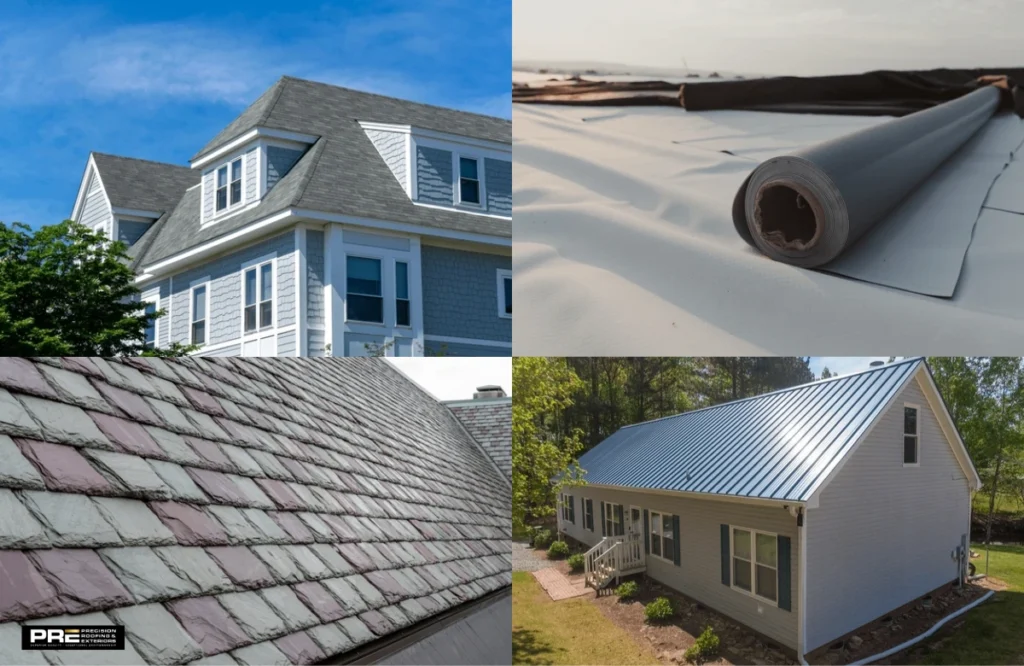Your roof is more than just protection; it adds beauty, saves energy, and increases the value of your home. Homeowners today can choose from many options. There are many different types of residential roofing materials, such as asphalt shingles, metal roofing, and clay tiles.
Other common choices include concrete tiles, slate, and wood shingles or shakes. Modern options like synthetic roofing, green roofing, solar tiles, and composite shingles are also growing in popularity. Each material has its own style, cost, and level of durability. Knowing the differences will help you choose the best fit for your budget and home.
Common Roofing Materials for Residential Properties
Here are the different types:
1. Asphalt Shingles
Asphalt shingles are one of the most common roofing materials. They are made of fiberglass or organic mat coated with asphalt and topped with ceramic granules. They are affordable, easy to install, and available in many designs. Most homeowners choose asphalt shingles for their balance of price, durability, and appearance. With regular care, they can last 15–30 years.
Benefits:
- Low cost and widely available.
- Simple and quick installation.
- Many styles and colors to choose from.
- It can last 15–30 years with proper care.
2. Metal Roofing
Metal roofs are growing in popularity because of their long life and strength. They are available in steel, aluminum, copper, or zinc, and can be shaped into panels or shingles. Metal roofing is fire-resistant and performs well in both hot and cold climates. It reflects sunlight, which lowers cooling costs in summer. While it is more expensive upfront, it can last for a long time with little maintenance.
Benefits:
- Very long lifespan (40–70 years or more).
- Strong against wind, rain, and fire.
- Reflects heat, reducing cooling costs.
- It can be recycled at the end of use.
3. Clay Tiles
Clay tiles are well-known for their traditional red color and curved shape. They are common in Spanish, Italian, and Mediterranean-style homes. Clay tiles are heavy but extremely durable, often lasting 50–100 years. They are also resistant to fire, insects, and rot. Because of their weight, they usually require extra roof support.
Benefits:
- Very durable, lasting 50–100 years
- Fire-resistant.
- Great for hot climates.
- Adds character and curb appeal.
4. Concrete Tiles
Concrete tiles are similar to clay tiles but are made with cement, sand, and water. They can mimic wood, slate, or clay tiles at a lower cost. Concrete is very durable and handles strong winds and storms well. They are heavier than asphalt shingles, so proper roof structure support is needed.
Benefits:
- Long-lasting, about 50–70 years.
- Resistant to fire and insects.
- Durable against strong winds.
- Many styles and colors are available.
5. Slate Roofing
Slate is one of the most premium roofing materials available. Made from natural stone, it offers unmatched beauty and elegance. Slate roofs can last over 100 years, making them one of the most durable options. They are resistant to fire, rot, and water absorption. However, slate is heavy and costly, so it may not be suitable for all homes.
Benefits:
- Lasts well over 100 years.
- Very elegant and natural look.
- Fireproof and water-resistant.
- Eco-friendly, made from natural stone.
6. Wood Shingles and Shakes
Wood shingles and shakes offer a natural, rustic look that blends beautifully with nature. Shingles are machine-cut and smooth, while shakes are hand-split and more textured. Wood roofs need regular care to prevent mold, rot, or insect damage. They perform well in dry climates but may require extra treatment in humid areas. With proper maintenance, they can last 25–30 years.
Benefits:
- Beautiful, natural look.
- Good insulation properties.
- It can last 25–30 years with proper care.
- Eco-friendly if sourced from sustainable wood.
7. Synthetic Roofing Materials
Synthetic roofing is designed to look like slate, clay, or wood but is made from plastic, rubber, or polymer. It is lighter and often less costly than natural materials. Many synthetic options are highly durable and resistant to cracks, fading, and impact. They are also easier to install and maintain compared to traditional heavy materials. This makes them a smart choice for homeowners who want the look of premium roofs without the high cost.
Benefits:
- Affordable compared to natural materials.
- Lightweight and easy to install.
- Resistant to cracking and fading.
- Many style options are available.
8. Composite Shingles
Composite shingles are made from materials like asphalt, fiberglass, and recycled products. They are designed to look like slate or wood but are lighter and more affordable. Composite shingles are durable, fire-resistant, and available in many colors. Their lifespan depends on quality but can range from 20 to 50 years. They are a flexible choice for many homeowners.
Benefits:
- Affordable and durable.
- Available in many colors and textures.
- Resistant to fire and impact.
- Lifespan ranges from 20 to 50 years, depending on quality.
Conclusion
There are many types of residential roofing materials, each offering its own benefits. Asphalt shingles are affordable, metal and slate are long-lasting, clay and concrete tiles bring style, while wood and synthetic offer natural beauty. Green roofs and solar tiles are modern and eco-friendly, while composite shingles offer balance and durability. The right choice depends on your budget, climate, and style.
If you’re ready to repair or replace your roof, contact professional roofing contractors Precision Roofing today for expert residential roof installation services and the perfect solution for your home.

